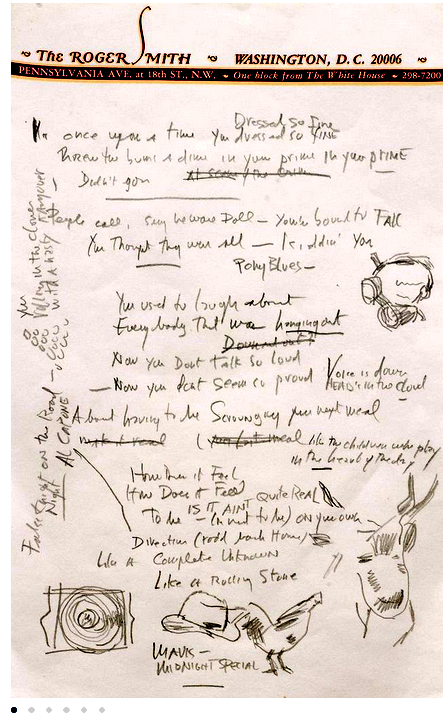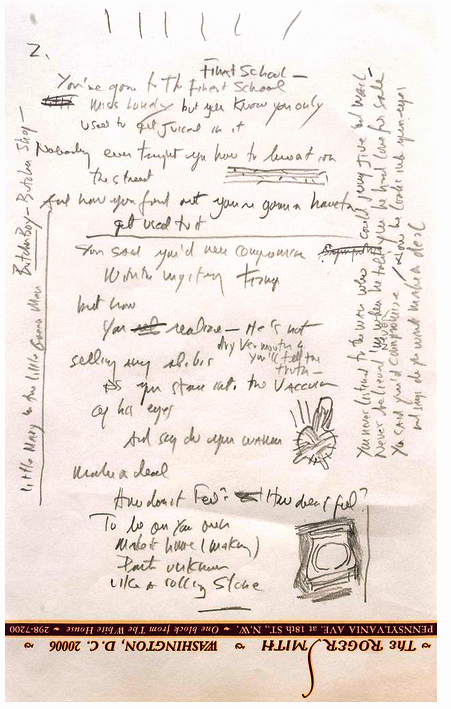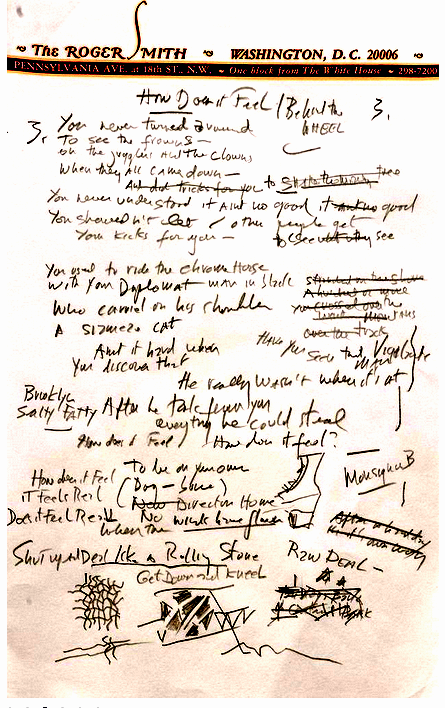
Madlib returns with this cool track, “Black Dreams (Sludge Fight).”
Check it out.
–- A Days of the Crazy-Wild blog post: sounds, visuals and/or news –-

Madlib returns with this cool track, “Black Dreams (Sludge Fight).”
Check it out.
–- A Days of the Crazy-Wild blog post: sounds, visuals and/or news –-

New track from Santigold, “Kicking Down Doors.”
Produced by Skrillex/OWSLA associate Yogi.
Check out the track over at SoundCloud.
By the way you might want to check out the “True Love Scars” soundtrack playlist here. It’s the music that goes with the first two chapters of my novel.
–- A Days of the Crazy-Wild blog post: sounds, visuals and/or news –
.jpg)
There are several stories circulating about Bob Dylan’s “Fourth Time Around.”
One version: According to Al Kooper: “I said to Dylan “it sounds so much like ‘Norwegian Wood,'” and he said “actually ‘Norwegian Wood’ sounds a lot like this! I’m afraid they took it from me and now I feel like I have to record it y’know.” Apparently he’d played it for them and they’d nicked it. I asked if he was worried about getting sued and he said, “nah, the Beatles could never sue me.”
Another version from Clinton Heylin:
The first week of December 1965 saw The Beatles release their finest collection to date, Rubber Soul. Though the United States edition was again pruned of several songs on the British original, one song that stayed the course had a largely Lennon lyric. Originally known as This Bird Has Flown, it was released as Norwegian Wood. The song was an important one to Lennon (he later said of it, “I was trying to be sophisticated in writing about an affair. But in such a smokescreen way that you couldn’t tell”). For the first time he was writing about something deeply personal – his clandestine affair with attractive journalist Maureen Cleave, whom Dylan also knew – using the kind of code the American had made something of a trademark.
Dylan undoubtedly recognized the influence and decided at some point to acknowledge it with his own version of “This Bird Has Flown.” For the past 18 months he had enjoyed dropping in the occasional lyrical nod with a wink to his new-found friends – a gesture they reciprocated on With A Little Help From My Friends in 1967. But Fourth Time Around was also a way of showing he could raise the bar lyrically on Lennon, the one Beatle to have aspirations beyond being a pop poet. Fourth Time Around is an altogether darker, more disturbing portrait of an affair, though it emulates Norwegian Wood in its circular melody and structure.
In any case, I’ve always dug “Fourth Time Around.”
Turns out very few artists have covered it. I found two that are worth a listen, and I’ve also included a bunch live versions by Dylan himself.
April 13, 1966, Sydney, Australia:
Yo La Tengo:
April 20, 1966, Melbourne, Australia:
Chris Whitley:
May 5, 1966: Dublin, Ireland:
Three versions by Robyn Hitchcock:
May 16, 1966, Sheffield, England:
May 26, 1966, Royal Albert Hall, London:
May 27, 1966, Royal ALbert Hall, London:
Bob Dylan, April 18, 1999:
–- A Days of the Crazy-Wild blog post: sounds, visuals and/or news –-

Lots of anticipation around the new Jack White album, plus lots of controversy thanks to White’s interview in Rolling Stone.
Lazaretto, is streaming a week ahead of its June 10 release date at iTunes Radio
–- A Days of the Crazy-Wild blog post: sounds, visuals and/or news –-

I like First Aid Kit’s two previous indie albums of chamber-folk.
Now the Swedish sisters Klara and Johanna Söderberg have signed to a major and this album, Stay Gold, their third, will be out on Columbia on June 10, 2014.
Meanwhile you can check out the whole album at NPR’s First Listen.
–- A Days of the Crazy-Wild blog post: sounds, visuals and/or news –-

Today a brand new official Bob Dylan recording went online at bobdylan.com, Dylan’s official website.
From Rolling Stone:
”This track is definitely from a forthcoming album due later on this year,” a spokesperson for the singer tells Rolling Stone. While the rep wouldn’t confirm an album title, Dylan posted an image of himself with the phrase “Shadows in the Night.” With its distinct vertical bars and crisp, minimalist text, the image appears to be in the style of graphic designer Reid Miles’ iconongraphic covers for jazz label Blue Note.
Here’s Sinatra’s version:
Listen to the song, a cover of Frank Sinatra’s 1945 hit “Full Moon and Empty Arms”:

Oh to have been a fly on the wall as Bob Dylan wrote some of his now classic songs.
Until time travel becomes possible, the closest we may get to observing Dylan the songwriter in action are the four pages from the working manuscript for “Like A Rolling Stone” that Sotheby’s will auction on June 24, 2014 in New York.
On the pages, along with many of the lines that ended up in what some believe is Dylan’s greatest song, a song that certainly changed people’s ideas of what rock ‘n’ roll could be upon it’s release in July of 1965, are lyrics that Dylan clearly was considering for inclusion, but which didn’t make the cut.
The chorus, for instance, didn’t fully come together until page four of the manuscript. On page one there is a version of the chorus that reads:
“How does it feel
How does it feel
To be (or not to be) on your own
Direction (road back home)
Like a complete unknown, like a rolling stone.”
Right below the second “How does it feel,” Dylan has added “Is it ain’t quite real.”
And at the side of the page it says “Al Capone” with a line drawn to the word “direction” in the chorus.

On the second page of the manuscript is a version of the chorus with “path unknown” as one of the lines.
At the top of page three is written: “How does it feel/ Behind the wheel.”
At the bottom of page three the chorus is again a work in progress:
How does it feel to be on your own
It feels real (dog-bone)
Does it feel real.”
Then he wrote “New direction home” but put a line through “new” and wrote “no” under it.
Then: “When the winds have (unreadable word that could be “flown”)
“Shut up and deal like a rolling stone
Raw deal
Get down and kneel.”

By page four this is the chorus:
“How does it feel, how does it feel
To be on your own
Like a dog without a bone
Now you’re unknown
Forever complete unknown
New direction home
No direction home
Like a rolling stone.”
“If you look at these four pages, you can see that at this stage there are rhyme schemes that he didn’t pursue, and I suppose the chorus is the biggest surprise,” Richard Austin, Sotheby’s manuscript expert, told the New York Times. “Here you have a chorus that is such an iconic piece of history, but it clearly didn’t arrive fully formed. And you wonder, if he chose another rhyme, would it have had the same impact?”
Dylan has written names of songs and books on the pages, which may or may not relate to the song itself: “Pony Blues,” a song by Charley Patton; “Midnight Special” (and above it “Mavis”); “On the Road”; and “Butcher Boy,” which likely refers to “The Butcher Boy,” an old folk song that the Clancy Brothers recorded.
“It was ten pages long,” Dylan once said of the manuscript for “Like A Rolling Stone.” “It wasn’t called anything, just a rhythm thing on paper all about my steady hatred directed at some point that was honest. In the end it wasn’t hatred, it was telling someone something they didn’t know, telling them they were lucky.”

There’s also a mostly discarded verse that reads:
“You never listened to the man who could (illegible) jive and wail
Never believed ‘m when he told you he had love for sale
You said you’d never compromise/ now he looks into your eyes
and says do you want make a deal.”
And what ended up being the third verse reads like this in part:
“You never turned around
To see the frowns
On the jugglers and the clowns
When they all came down
And did tricks for you to shake the money tree.”
There’s a line drawn through that entire last line.
The four manuscript pages for “Like A Rolling Stone” could sell for as much as $2 million.
Get the back story from the New York Times and Rolling Stone.
Dylan singing “Like A Rolling Stone”:
– A Days of the Crazy-Wild blog post: sounds, visuals and/or news –-

New album due from Brian Eno and Karl Hyde, Someday World, will be released on May 6, 2014.
Right now you can give it a listen here.
– A Days of the Crazy-Wild blog post: sounds, visuals and/or news –-

The new Lykke Li album will be released May 6, 2014, but meanwhile you can stream the whole thing over at NPR.
Go For it.
– A Days of the Crazy-Wild blog post: sounds, visuals and/or news –-

Fifty-two years ago, on April 25, 1962, the second session for The Freewheelin’ Bob Dylan took place at Columbia Studio A in New York.
That day, according to Clinton Heylin’s “Bob Dylan: The Recording Sessions [1960 – 1994]” the following songs were recorded.
(It’s possible that some of these were cut at a different session since Dylan rerecorded some songs on different days.)
“Solid Road (Rocks and Gravel)”:
“Let Me Die in my Footsteps”:
“Talkin’ Hava Negeilah Blues”:
“Sally Gal”:
“Baby, Please Don’t Go”:
“Milk Cow Blues” #1:
“Milk Cow Blues” #2:
“Wichita Blues” #1:
“Wichita Blues” #2:
“Talkin’ Bear Mountain Picnic Massacre Blues”: